In the bustling marketplace of brands, each jostling for consumers’ attention and loyalty, what is it that makes a few brands stand apart? How do they break through the noise, captivate audiences, and establish themselves as industry leaders? The answers, while complex, lay in the anatomy of a successful brand.
Successful brands, those that are distinct, memorable, and influential, share a common trait: They do more than sell products or services. They create narratives, shape perceptions, and evoke emotions. They make us feel connected, understood, and even inspired.
Let’s take Apple, for example. While they are undeniably a tech company, selling phones, computers, and gadgets, they present themselves as much more. Their branding doesn’t focus on the technical specifications of their products; instead, it centers around the concepts of innovation, design, and the user experience. They have built an identity that resonates with their consumers and reflects their ethos of “thinking different.”
So how can other brands replicate such success? How can they create their unique narrative that propels them from being just another name in the marketplace to becoming a beloved and influential brand?
The first step lies in introspection. Brands must understand their core values and how they wish to be perceived. Are they pioneers, challenging the status quo like Tesla? Or are they comforters, providing familiar reliability like McDonald’s? Knowing this identity forms the foundation of the brand’s narrative.
Next, successful brands know their audience well. Not just the demographic data, but the more nuanced aspects like their hopes, fears, values, and motivations. Armed with this understanding, brands can create stories and messages that resonate deeply with their audience, resulting in a strong emotional connection.
Another critical aspect is consistency. Brands like Coca-Cola and Nike have maintained their core messaging and values across decades. This consistent reinforcement strengthens the brand image in consumers’ minds and builds trust. It doesn’t mean brands can’t evolve – they should – but the evolution should align with the established brand identity.
Moreover, successful brands are not afraid to take a stance. In a world where consumers increasingly prefer brands that align with their social and political beliefs, silence or fence-sitting can be detrimental. Brands like Patagonia and Ben & Jerry’s, known for their active stand on environmental and social issues, have cultivated a loyal consumer base that shares their values.
Lastly, in the words of Amazon’s Jeff Bezos, “Your brand is what other people say about you when you’re not in the room.” Successful brands consistently deliver high-quality products or services and exceptional customer experiences. They understand that every interaction with a consumer, no matter how insignificant, is an opportunity to reinforce their brand image.
In conclusion, successful branding is an intricate blend of introspection, audience understanding, consistency, courageous stances, and above all, delivering on promises. The anatomy of a successful brand isn’t just about eye-catching logos or catchy taglines; it’s about the emotional and psychological relationship between a brand and its consumers.
So, as you embark on your brand-building journey, remember: A brand is much more than a product or a company. It’s a story, an experience, and an identity. Make it one that stands out in the crowd.
Did these insights capture your attention? Are you thinking about exploring the fascinating world of marketing, strategy, or sales? You’re at the perfect place. Paul Conant, an accomplished expert in business growth with a stellar track record, is ready to navigate you through these terrains.
Whether you’re a startup striving to stand out or a well-established brand looking to exploit influential networks, Paul’s counsel is an invaluable resource. With over 30 years of enriching experience, he has assisted numerous businesses in propelling their sales and growth across a range of sectors.
Prior to Gizoom, his triumphant enterprise, Paul made remarkable progress in the electronics industry, further fortifying his business expertise. Presently, he applies this vast knowledge to provide astute advice on a variety of business issues while also serving as a fractional Chief Marketing Officer, formulating dynamic strategies.
Embarking on a journey in marketing, strategy, and sales doesn’t have to be intimidating. Guided by the right mentor, it becomes an exciting adventure ripe with opportunities for growth and success. Ready to kickstart this journey? Don’t wait, contact Paul Conant today to book an appointment, and set your business on the path to achieving its maximum potential. https://gizoom.com/book-an-appointment/















